Mind the Web Gap, Please: Challenges in Bridging the Interactive Agency Divide
"We think your [insert creative, copywriting, print design, branding, positioning, ... here] is the best of the bids... but can you do [insert custom development, email marketing, interactive web design, content management systems, ... here]?" With advertising and marketing dollars continuing to shift to the internet traditional advertising agencies, marketing and PR firms, and print designers can no longer escape having an answer to their client's internet needs.
So just how difficult is it to forge a path from being an Awesome Agency to an Awesome Agency (That does their Awesome work on the Web, too)? There's only challenge standing between them, right? A little thing called the web.
Without a support infrastructure for the web an agency's core competencies won't make it safely to the "other side". The good news is the demand is continuing to grow on-line for better website copy, skillful graphic design, and all-around thoughtful creative. Most agencies have the right pieces to create value on the web, they're just missing a support beam to keep from drowning in the alphabet-soup of technologies: HTML, JS, CSS, XML, JSON, FTP, etc.
As an established agency, this is today's most important juncture: the realization that your core competencies have a growing demand on-line, but you can not meet the demand without stronger technological support.
How does an agency bridge the gap, then? Let's start with the most common approach: obtaining competency in HTML, CSS, and JavaScript.
The Triumvirate Beam Bridge Support: HTML, CSS, and JavaScript
An agency learns HTML, CSS, and JS or hires someone that does. Now when your client asks "can you create a website along with your branding work?" you've got an answer. Need to put your copywriting on websites, forms, site maps, landing pages: no big deal. All of these elements are a part of your pitch now. The more you pitch interactive and learn about the web the more you realize the problem with this solution: the distance between being a traditional agency and an interactive agency isn't much wider than you originally thought, but the web is a heck of lot deeper than you thought.
It's not long before knowing HTML, CSS, and JavaScript just isn't enough to do the awesome web work your clients are after. The problem with the web is that new technology and techniques are always being invented and it's only growing deeper. At first static websites are all you need to know how to do. Pretty soon it's dynamic websites with custom programming in an obscure programming language that needs to integrate with Twitter and accepts payments from a form that does javascript input validation and hooks securely into a merchant account.
When agencies first get their hands dirty with web technology it is difficult to appreciate the significance of a couple major points:
- Growing a technological competency involves growing in a very different direction from expanding existing core competencies.
- Learning a valuable new web technology or technique today doesn't mean it will solve your client's problems tomorrow.
Because the web is ever changing agencies can't bridge the interactive divide by stacking up technologies one-by-one. Instead, if a traditional agency is after sustainable success on-line, the traditional agency must build a different kind of bridge suspended from two new, vital core competencies.
The Cable-stayed Bridge to a Sustainable Interactive Agency
The two core competencies necessary to stay relevant on the internet are:
- Understanding and Appreciation of Programming Fundamentals
- An Obsession with Learning New Technology
Traditional agencies looking for long-term success on-line must either grow these competencies in-house, or partner with a technology focused firm (shameless plug) whose core competencies are already programming and learning new technology. The right direction is a strategical decision that depends on the size of an agency, its existing staff, risk tolerance, available funding, and how quickly it needs interactive capability. That's another blog post in itself.
Bottom line: Travel with caution when crossing the interactive divide. The web is a lot deeper than you probably think.
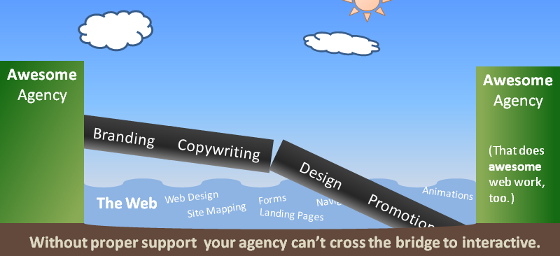
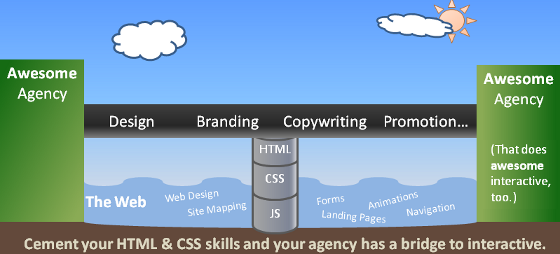
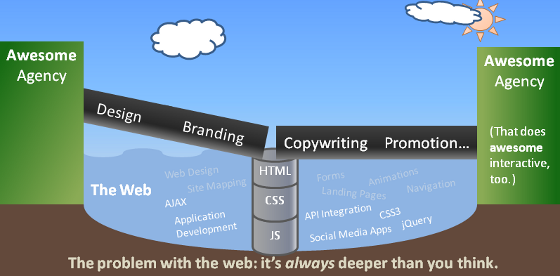
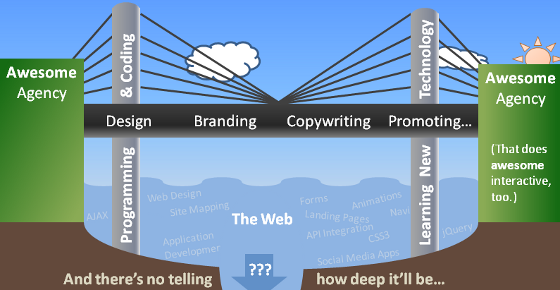
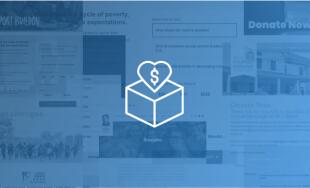


Comments
Jessica
The thing customers have when they visit your site is time and money, they don't like parting with either, so you have to convince them to by making your site as informative and easy to use as possible.
Johnathan
Your first act to interactive, is the web site, that you must have in todays information age. No web site no business, or at least not for long.
Now a smart business owner would look at ways to make his site more interactive.
How do we go about that you ask?
Its easy, ask your customers.
What can we do to our site that would save you time, or make it easier?
You apply what they say from thier feedback, and you have just made steps towards making your site interactive. The easier you make it for your customers the more they will use it.
Noel
Nothing has ever frustrated me more than talking with a fellow designer, and hearing them say oh, no thats your world, I only do print.
Or I can't layout the brochure because I only do websites.
We are designers above all else.
Brochures websites, flash, video are all mediums that have their own unique design challenges.
Why even if the economic times where good would we limit our design solutions to just one medium?
Hence our motto.
Specializing in creatives for online offline and all points in between
--
Thanks & Regards
Noel from nopun.com
a professional graphic design studio
Leave a comment